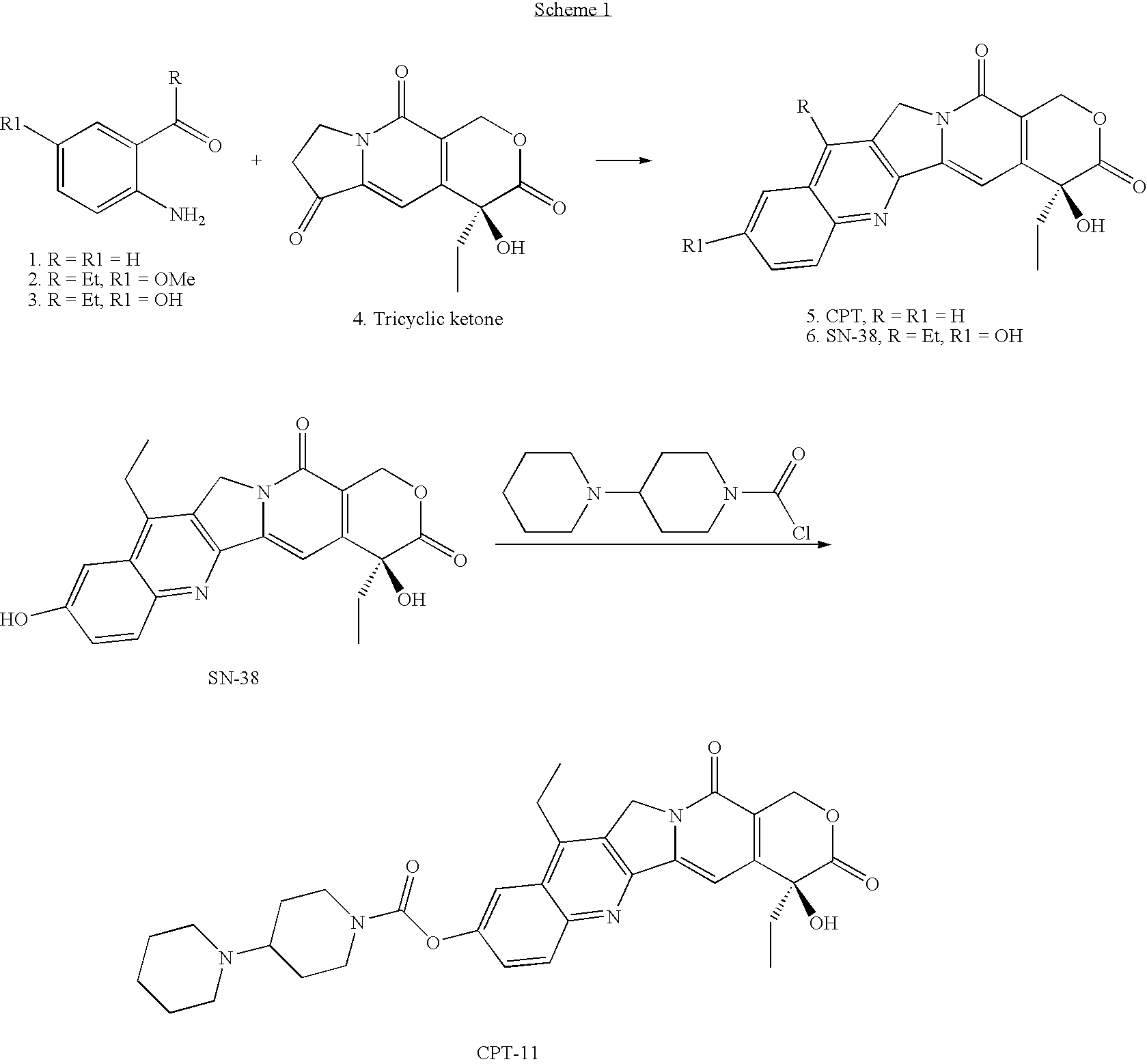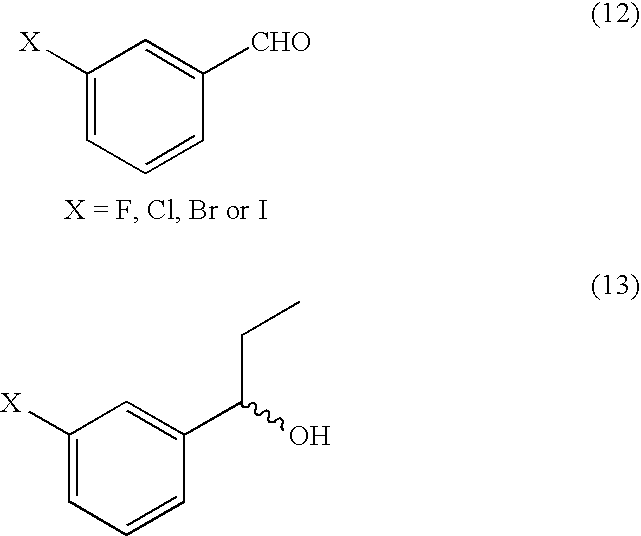Method of Synthesizing Key Intermediates for the Production of Camptothecin Derivatives
- Summary
- Abstract
- Description
- Claims
- Application Information
AI Technical Summary
Benefits of technology
Problems solved by technology
Method used
Image
Examples
example 1
Preparation of 1-(3-fluorophenyl)propan-1-ol
[0036]18 L ethyl bromide were dissolved in 30 L of THF and added dropwise to a suspension of 6 kg of magnesium in 30 L of THF. The reaction solution was next stirred for two hours at 65° to 75° C. and then cooled to 0 to 10° C. 15 kg of 3-fluorobenzaldehyde in 60 L of THF were added while cooling with ice over a period of 6 hr and the reaction solution was stirred overnight at room temp. The reaction solution was quenched with saturated ammonium chloride solution at 0°-10° C. The reaction solution was stirred for one hour, organic layer separated and concentrated. The concentrate was extracted with 40 L of DCM and washed with 30 L of 5% HCl solution. The solvent was removed in vacuo. After drying, 20 kg of 1-(3-Fluoro-phenyl)-propan-1-ol were obtained as a brown oil and taken as such to the next step.
[0037]1H NMR (CDCl3): δ=0.88 (t, 3H, —CH2— C), 1.75 (m, 2H, —CH2—CH3), 4.55 (t, 1H, —CH—O), 6.9-7.4 (m, 4H, ArH)
example 2
Preparation of 3-fluoropropiophenone
[0038]350 ml of Jones reagent was added dropwise to 100 g of 1-(3-fluorophenyl)propan-1-ol in 1 L of acetone at 0 to 10° C., over a period of two hours. The reaction solution was stirred at 0 to 10° C. for additional 1 hour. The solvent was removed in vacuo. The reaction solution was extracted with 400 ml of DCM and organic layer was dried over sodium sulfate. The solvent was removed in vacuo. After drying, 120 g of 3-fluoropropiophenone were obtained as a yellow oil and taken as such to the next step 1H NMR (CDCl3): δ=1.3 (t, 3H, —CH2—CH3, 2.95 (q, 2H, CO—CH2—CH3), 7.25 (m, 1H, Ar 5-H), 7.43 (m, 1H, Ar-4H), 7.63 (q, 1H, Ar-6H), 7.75 (bd, 1H, Ar-4H)
example 3
Preparation of 5-fluoro-2-nitropropiophenone
[0039]3 L of fuming nitric acid was added dropwise to 1 kg of 3-fluoropropiophenone at −5 to 5° C., over a period of eight hours. The reaction solution was stirred at 0° C. for two hours. The reaction solution was carefully poured on crushed ice and stirred for 1 hour. The cold solution was filtered and the solids obtained were extracted with 6 L of DCM. The organic layer was separated and washed twice with 3 L of 5% NaHCO3 solution each time and the combined DCM extracts were dried over sodium sulfate. The solvent was removed in vacuo. After drying, 775 g (98%) of 5-fluoro-2-nitropropiophenone were obtained as a yellow liquid, taken as such to next step.
[0040]1HNMR (CDCl3): δ=1.25 (t, 3H, —CH2—CH3), 2.75 (q, 2H, CO—CH—CH3), 7.06 (m, 1H, Ar H), 7.28 (m, 1H, Ar H), 8.22 (m, 1H, Ar H).
PUM
| Property | Measurement | Unit |
|---|---|---|
| Polarity | aaaaa | aaaaa |
Abstract
Description
Claims
Application Information
 Login to View More
Login to View More - R&D
- Intellectual Property
- Life Sciences
- Materials
- Tech Scout
- Unparalleled Data Quality
- Higher Quality Content
- 60% Fewer Hallucinations
Browse by: Latest US Patents, China's latest patents, Technical Efficacy Thesaurus, Application Domain, Technology Topic, Popular Technical Reports.
© 2025 PatSnap. All rights reserved.Legal|Privacy policy|Modern Slavery Act Transparency Statement|Sitemap|About US| Contact US: help@patsnap.com



